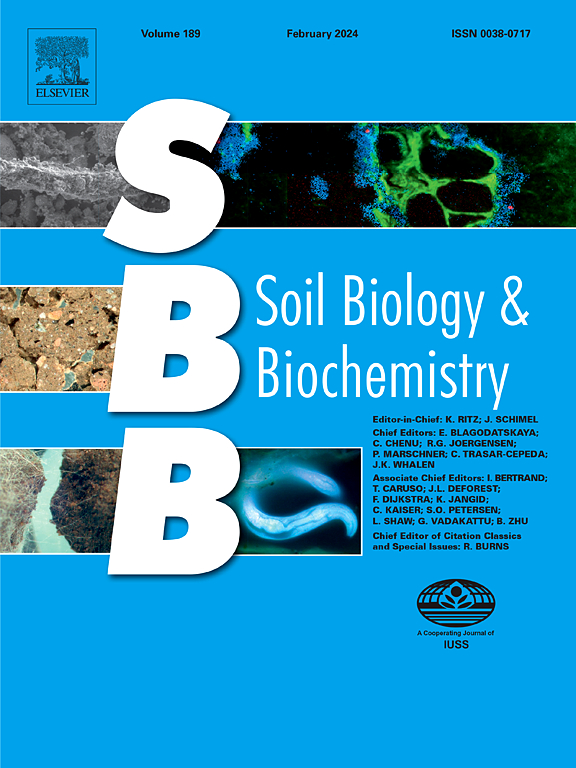Microbial taxa and interactions can predict lignin mineralization in soil at continental scale
IF 9.8
1区 农林科学
Q1 SOIL SCIENCE
引用次数: 0
Abstract
Individual fungi and bacteria can decompose lignin, but little is known about how specific taxa and their interactions may be related to this critical carbon-cycling process across diverse environments. We characterized relationships between bacterial and fungal communities and mineralization of isotope-labeled lignin across 156 incubated mineral soil samples collected from 20 National Ecological Observatory Network sites spanning diverse ecosystems (tundra to tropics) across North America. Based on marker gene sequencing, bacteria were more closely related to lignin mineralization than fungi at the levels of overall community composition, individual taxa, and co-occurrence network. We identified 14 bacterial and fungal genera across sites and 26 taxa (mostly bacteria) within sites, including two genera (Occallatibacter and Terracidiphilus) that were significantly related to lignin mineralization within and across sites. Additionally, many microbial ‘modules’ from co-occurrence networks were related to lignin mineralization, and this was even more evident during the later stages of decomposition. This suggests the importance of microbial interactions for lignin decay and implies that microbes interacted in a way favoring lignin decomposition over the incubation. We identified 10 bacterial-fungal interactions (BFI) that could significantly strengthen and 10 BFI that could weaken microbial relationships with lignin mineralization, indicating that synergistic and antagonistic BFI were both important. Overall, our study illustrated the key importance of microbial interactions even more so than individual taxa for predicting lignin mineralization.
微生物类群及其相互作用可以预测大陆尺度土壤木质素矿化
单个真菌和细菌可以分解木质素,但对于特定的分类群及其相互作用如何与不同环境中这一关键的碳循环过程相关,人们知之甚少。我们分析了细菌和真菌群落与同位素标记木质素矿化之间的关系,这些样品来自北美20个国家生态观测站网络站点,涵盖了不同的生态系统(苔原到热带)。标记基因测序结果表明,细菌与木质素矿化在总体群落组成、单个分类群和共生网络水平上的关系比真菌更密切。我们鉴定出14个跨站点的细菌和真菌属和26个站点内的分类群(主要是细菌),其中包括两个与站点内和站点间木质素矿化显著相关的属(Occallatibacter和Terracidiphilus)。此外,来自共生网络的许多微生物“模块”与木质素矿化有关,这在分解的后期阶段更为明显。这表明微生物相互作用对木质素衰变的重要性,并暗示微生物相互作用的方式有利于木质素分解而不是孵育。我们发现了10种细菌-真菌相互作用(BFI)可以显著加强和10种BFI可以削弱微生物与木质素矿化的关系,表明增效和拮抗BFI都很重要。总的来说,我们的研究说明了微生物相互作用的关键重要性,甚至比单个分类群更能预测木质素矿化。
本文章由计算机程序翻译,如有差异,请以英文原文为准。
求助全文
约1分钟内获得全文
求助全文
来源期刊

Soil Biology & Biochemistry
农林科学-土壤科学
CiteScore
16.90
自引率
9.30%
发文量
312
审稿时长
49 days
期刊介绍:
Soil Biology & Biochemistry publishes original research articles of international significance focusing on biological processes in soil and their applications to soil and environmental quality. Major topics include the ecology and biochemical processes of soil organisms, their effects on the environment, and interactions with plants. The journal also welcomes state-of-the-art reviews and discussions on contemporary research in soil biology and biochemistry.
 求助内容:
求助内容: 应助结果提醒方式:
应助结果提醒方式:


